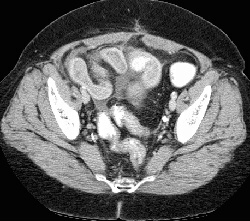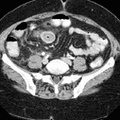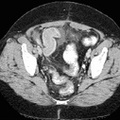
RADIOLOGY: GASTROINTESTINAL: GI: Case# 32878: CROHNS DISEASE. The patient is a 62 year old black female with history of Crohns disease. Surgical history includes ileocecal anastomosis secondary to removal of Meckels diverticulum, appendectomy, cholecystectomy, and bilateral salpingo- oophorectomy. The terminal ileum appears to have been removed with evidence of ileocecal anastomosis. The distal ileum is dilated and demonstrates concentric thickening. Free intraperitoneal fluid and inflammatory changes are seen in the region of the thickening in the right lower quadrant. The remainder of the small bowel and colon is within normal limits. No fistulous tracts or abscesses are identified. The patient is S/P hysterectomy and bilateral salpingo-oophorectomy, and cholecystectomy. Crohns Disease, an idiopathic chronic inflammatory disease, most commonly involves the ileocecal portion of the bowel or the colon, although it is possible for any portion of the gastrointestinal tract to be affected. Morphologically, Crohns disease is characterized by thickening of involved segments with narrowing of the lumen, linear ulceration of the mucosa, submucosal edema with elevation of the surviving mucosa producing a "cobblestone" appearance, skip lesions, possible discrete noncaseating granulomas, and submucosal fibrosis. Clinical manifestations include abdominal pain, diarrhea, malabsorption, fever, intestinal obstruction resulting from stricture, and fistulae between loops of intestine, and between the intestine, bladder, vagina, and skin. CT findings include circumferential thickening of the bowel wall up to 1 to 2 cm, a low density inner ring of submucosal edema, diffuse haziness and increased density of messenetric fat, "skip areas" of normal bowel interspersed between diseased segments, fistulae and sinus tracts between bowel loops, or to the bladder, adjacent muscle, or the skin surface, and messenteric abcscesses containing fluid, air, or contrast material.
- Author
- Peter Anderson
- Posted on
- Thursday 1 August 2013
- Tags
- gastrointestinal, radiology
- Albums
- Visits
- 808


0 comments